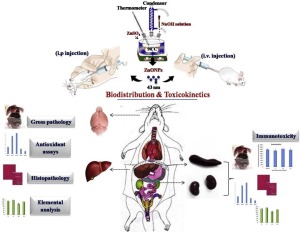当前位置:
X-MOL 学术
›
Colloids Surf. B Biointerfaces
›
论文详情
Our official English website, www.x-mol.net, welcomes your
feedback! (Note: you will need to create a separate account there.)
Determination of the bioavailability of zinc oxide nanoparticles using ICP-AES and associated toxicity.
Colloids and Surfaces B: Biointerfaces ( IF 5.4 ) Pub Date : 2019-12-30 , DOI: 10.1016/j.colsurfb.2019.110767 Sudhakaran S 1 , Athira Ss 1 , Suresh Babu S 1 , Varma Hk 1 , Mohanan Pv 1
Colloids and Surfaces B: Biointerfaces ( IF 5.4 ) Pub Date : 2019-12-30 , DOI: 10.1016/j.colsurfb.2019.110767 Sudhakaran S 1 , Athira Ss 1 , Suresh Babu S 1 , Varma Hk 1 , Mohanan Pv 1
Affiliation

|
Advancement in nanotechnology has brought abundant number of products and materials in multiple fields including biomedicine owing to their unique physico-chemical properties. This further necessitates toxicity assessment of nanoparticles (NPs) before they are employed for product fabrication, medicinal, environmental or industrial purposes. Zinc oxide nanoparticles (ZnONPs) belong to the category of metal oxide NPs and hold quite a lot of possibilities to be applied in aforementioned scenarios. Present study addresses the probable outcomes of bio-nano interaction of ZnONPs with healthy adult Wistar rats. Sphere head shaped ZnONPs were synthesized via wet chemical method. Physico-chemical characterization was performed using number of sophisticated techniques including HR-TEM, Zeta potential analysis, TGA and XRD. Size of the particles was found to be 43 nm and ensured homogenous distribution with high purity. For in vivo studies, as synthesized NPs were administered into rats via intravenous (i.v.) and intraperitoneal (i.p.) routes. Animals were sacrificed on 3rd, 14th and 21st day of exposure. Metabolically relevant tissues like brain, liver, kidneys and spleen were isolated and analyzed for different parameters like gross pathology, haematology, neurotoxicity, target organ toxicity, immunotoxicity etc. Results suggests that ZnONPs did not elicit significant toxic responses in rat except a few anomalies with histology, ion content and antioxidant system within liver; thereby confirming potent hepatotoxicity. Hence the study recommends adopting surface functionalization strategies for reducing toxic response of ZnONPs during various application rationales.
中文翻译:

使用 ICP-AES 和相关毒性测定氧化锌纳米颗粒的生物利用度。
纳米技术的进步为包括生物医学在内的多个领域带来了大量的产品和材料,因为它们具有独特的物理化学性质。这进一步需要在纳米颗粒 (NP) 用于产品制造、医药、环境或工业目的之前对其进行毒性评估。氧化锌纳米粒子 (ZnONPs) 属于金属氧化物 NPs 的范畴,在上述场景中具有相当多的应用可能性。目前的研究解决了 ZnONPs 与健康成年 Wistar 大鼠的生物纳米相互作用的可能结果。通过湿化学方法合成球头状ZnONPs。使用多种复杂技术进行物理化学表征,包括 HR-TEM、Zeta 电位分析、TGA 和 XRD。发现颗粒的尺寸为 43 nm,并确保高纯度的均匀分布。对于体内研究,合成的纳米颗粒通过静脉内 (iv) 和腹腔内 (ip) 途径给药于大鼠。在暴露的第 3、14 和 21 天处死动物。分离与代谢相关的组织,如脑、肝、肾和脾脏,并分析不同参数,如大体病理学、血液学、神经毒性、靶器官毒性、免疫毒性等。结果表明,除了少数异常肝脏内的组织学、离子含量和抗氧化系统;从而证实了有效的肝毒性。因此,该研究建议在各种应用原理中采用表面功能化策略来减少 ZnONPs 的毒性反应。
更新日期:2019-12-30
中文翻译:

使用 ICP-AES 和相关毒性测定氧化锌纳米颗粒的生物利用度。
纳米技术的进步为包括生物医学在内的多个领域带来了大量的产品和材料,因为它们具有独特的物理化学性质。这进一步需要在纳米颗粒 (NP) 用于产品制造、医药、环境或工业目的之前对其进行毒性评估。氧化锌纳米粒子 (ZnONPs) 属于金属氧化物 NPs 的范畴,在上述场景中具有相当多的应用可能性。目前的研究解决了 ZnONPs 与健康成年 Wistar 大鼠的生物纳米相互作用的可能结果。通过湿化学方法合成球头状ZnONPs。使用多种复杂技术进行物理化学表征,包括 HR-TEM、Zeta 电位分析、TGA 和 XRD。发现颗粒的尺寸为 43 nm,并确保高纯度的均匀分布。对于体内研究,合成的纳米颗粒通过静脉内 (iv) 和腹腔内 (ip) 途径给药于大鼠。在暴露的第 3、14 和 21 天处死动物。分离与代谢相关的组织,如脑、肝、肾和脾脏,并分析不同参数,如大体病理学、血液学、神经毒性、靶器官毒性、免疫毒性等。结果表明,除了少数异常肝脏内的组织学、离子含量和抗氧化系统;从而证实了有效的肝毒性。因此,该研究建议在各种应用原理中采用表面功能化策略来减少 ZnONPs 的毒性反应。











































 京公网安备 11010802027423号
京公网安备 11010802027423号